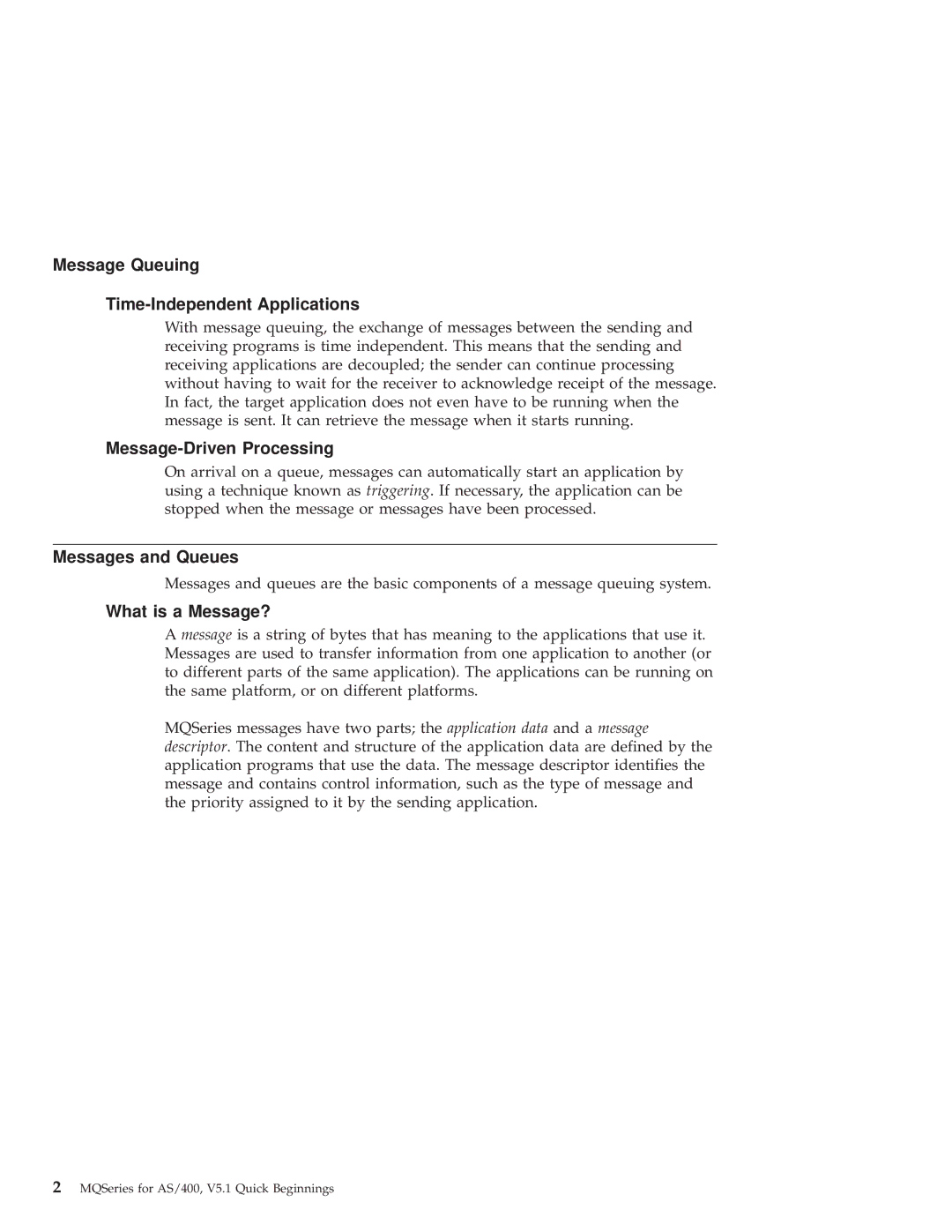IBM
Page
IBM
First edition March
Contents
Planning to Install MQSeries Clients
Appendix B. Applying Maintenance to MQSeries for AS/400 103
Vi MQSeries for AS/400, V5.1 Quick Beginnings
Tables
Viii MQSeries for AS/400, V5.1 Quick Beginnings
Welcome to MQSeries for AS/400
Conventions
MQSeries for AS/400, V5.1 Quick Beginnings
MQI ± a Common Application Programming Interface
About MQSeries
Message Queuing
Message-Driven Processing
What is a Message?
Message Queuing Time-Independent Applications
Messages and Queues
Messages and Queues What is a Queue?
MQSeries Objects
MQSeries Objects Queue Managers
Queues
MQSeries Objects Process Definitions
Channels
MQSeries Objects Namelists
Clients and Servers
Queue manager events
Instrumentation Events
Types of Event
Performance events
Transactional Support
MQSeries queue manager clusters
MQSeries Administration Interface Mqai
Whats New in MQSeries for AS/400
Support for Windows 98 clients
Whats New
Message size
Administration application
Message queue size
Whats New
Disk Space Required
Planning to Install the MQSeries for AS/400 Server
Hardware Requirements
Software Requirements
QMQM29xx
Connectivity AS/400 Install Libraries and Directories
AS/400 Library Structure
QMxxxx Library
QIBM/UserData/mqm
IFS Root File System
QIBM/ProdData/mqm
MQSeries for AS/400 Components
Connectivity User Profiles
Delivery
MQSeries online documentation
Creating the System-Default Objects
Samples
Readme file
MQSeries for AS/400, V5.1 Quick Beginnings
Setting System Values
Installing, Migrating to, and Deleting MQSeries for AS/400
Before Installation
Qccsid
Reinstallation
Installation Installation Procedure
Installation of Translated Versions
Verifying the Installation
Post Installation Tasks
Quiescing MQSeries
Quiescing previous releases of MQSeries for AS/400
Quiescing MQSeries Quiescing V5.1 of MQSeries for AS/400
Migrating to MQSeries for AS/400
Migrating MQSeries What are the Differences
Overview of Migration Process
Migrating MQSeries
Before Migration
Migration
Call PGMQMQM/MIGRATEMQM
Verifying the Migration
Migration Verification
After Migration
Entire Deletion
Deleting MQSeries Deleting MQSeries for AS/400
Standard Deletion
Deleting MQSeries
Before you Start
Using MQSeries for AS/400
Introducing Command Sets
Before you Start CL Commands
Using CL Commands
Command
MQSeries Mqsc Commands
Running Mqsc Commands
Creating a Queue Manager
Before you Start PCF Commands
Working with MQSeries
Starting a Queue Manager
Creating a Local Queue
Create MQM Queue panel part
PTY SYSDFTQ, *PTY, *FIFO
Clearing a Local Queue
Working with MQSeries Sending a Test Message
Browsing Queues
Deleting a Local Queue
Other Things to Do
Deleting a Queue Manager
Checking what Queue Managers you have Running
Setting the Queue Manager Ccsid for MQSeries for AS/400
User Exits
MQSeries for AS/400, V5.1 Quick Beginnings
AIX Client Hardware and Software Required
Planning to Install MQSeries Clients
Applications on Version 5 Clients
Hardware
Components for AIX
Hardware and Software, AIX
Compilers for MQSeries Applications on AIX Clients
Connectivity
MQSeries Internet Gateway documentation
Digital Unix Client Hardware and Software Required
MQSeries Client for Java
MQSeries Internet Gateway
DOS Client Hardware and Software Required
Compilers for MQSeries Applications on DOS Clients
MQSeries Toolkit
Components for DOS
HP-UX Client Hardware and Software Required
Components for HP-UX
OS/2 Warp Client Hardware and Software Required
Components for OS/2 Warp
Hardware and Software, OS/2 Warp
Compilers for MQSeries Applications on OS/2 Warp Clients
MQSeries Development Toolkit
Sun Solaris Client Hardware and Software Required
Components for Sun Solaris
Hardware and Software, Sun Solaris
Compilers for MQSeries Applications on Sun Solaris Clients
Windows 3.1 Client Hardware and Software Required
Components for Windows
Optional software
Compilers for MQSeries Applications on Windows NT Clients
Components for Windows 95 and Windows
Windows NT Client Hardware and Software Required
Hardware and Software, Windows NT
Components for Windows NT
Installing MQSeries Clients
Installing on AIX
Before Installation
Creating Another File System for the Client
Creating the mqm User ID and Group
Easy Installation
Select /dev/cd0 CD-ROM Drive
Custom Installation
Click on Install/Update
Changes to the Installation Path
Changing the National Language
Translated Messages
Installing on DOS
Using Setup
Removing an MQSeries Client from AIX
Installing on HP-UX
Removing an MQSeries Client from DOS
Installing on OS/2 Warp
Installation
Kernel Configuration Translated Messages
Removing an MQSeries Client from HP-UX
Installing on OS/2 Warp
READ.ME
Unattended Installation on OS/2 Warp
Directory Language
Starting Unattended Installation
Installation and Maintenance Parameters
Installation and maintenance parameters are as follows
Ssource location
Installation Response Files
Keywords for Response Files
Actions Install
Actions Delete
Response File Structure
Installing on Sun Solaris
Removing an MQSeries Client from OS/2 Warp
Usr/bin/ps -ef /bin/grep vold
Installing on Windows 95 or Windows
Removing an MQSeries Client from Sun Solaris
Installing on Windows 95 or Installation
Setting up the Server
Installing on Windows 95 or
Unattended Installation on Windows 95 and Windows
Installing on the Remote Machine
Installing on Windows
Removing an MQSeries Client from Windows 95 and Windows
Run setup.exe MQSeries Welcome window is displayed
Removing an MQSeries Client from Windows
Installing on Windows NT
Installation Procedure
Installing on Windows NT
Installing on Windows NT Installing from a LAN
Creating SMS Packages and Jobs for MQSeries
Creating the MQSeries SMS Software Package
Unattended Installation on Windows NT
Creating the MQSeries SMS Job
Logfile
Responsefile
Removing an MQSeries Client from Windows NT
Classes for Java
Secondarylogfile
Configuring a Client Configuring and Verifying a Client
Obtaining Additional Information
Order Title Description Number AS/400 Specific Books
Additional Information
Order Title Description Number
Hardcopy Books
Online Information
Online Information Publications CD-ROM
CD-ROM books directory
Book File Name
CD-ROM amqaa60w directory
CD-ROM readme directory
Online Information BookManager CD-ROMs
Online Help
MQSeries for AS/400, V5.1 Quick Beginnings
Appendix A. Sample MQI Programs
COBOL, and RPG Program Samples
Samples
QMQM/QRPGSRC
Appendix A. Sample MQI Programs
MQSeries for AS/400, V5.1 Quick Beginnings
Appendix B. Applying Maintenance to MQSeries for AS/400
Reinstalling MQSeries for AS/400
MQSeries for AS/400, V5.1 Quick Beginnings
Appendix C. Notices
105
MQSeries for AS/400, V5.1 Quick Beginnings
Trademarks
MQSeries for AS/400, V5.1 Quick Beginnings
Index
MQI
Qccsid
Smit
MQSeries for AS/400, V5.1 Quick Beginnings
Sending your comments to IBM
Ibmr
IBM
